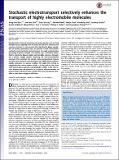| dc.contributor.author | Keller, Philipp J. | |
| dc.contributor.author | Kim, Sung-Yon | |
| dc.contributor.author | Cho, Jae Hun | |
| dc.contributor.author | Murray, Evan | |
| dc.contributor.author | Bakh, Naveed Ali | |
| dc.contributor.author | Choi, Heejin | |
| dc.contributor.author | Ohn, Kimberly | |
| dc.contributor.author | Ruelas, Luzdary T. | |
| dc.contributor.author | Hubbert, Austin W. | |
| dc.contributor.author | McCue, Margaret Grace | |
| dc.contributor.author | Ling, Sara Lynn | |
| dc.contributor.author | Chung, Kwanghun | |
| dc.date.accessioned | 2017-05-05T19:06:28Z | |
| dc.date.available | 2017-05-05T19:06:28Z | |
| dc.date.issued | 2015-11 | |
| dc.date.submitted | 2015-05 | |
| dc.identifier.issn | 0027-8424 | |
| dc.identifier.issn | 1091-6490 | |
| dc.identifier.uri | http://hdl.handle.net/1721.1/108706 | |
| dc.description.abstract | Nondestructive chemical processing of porous samples such as fixed biological tissues typically relies on molecular diffusion. Diffusion into a porous structure is a slow process that significantly delays completion of chemical processing. Here, we present a novel electrokinetic method termed stochastic electrotransport for rapid nondestructive processing of porous samples. This method uses a rotational electric field to selectively disperse highly electromobile molecules throughout a porous sample without displacing the low-electromobility molecules that constitute the sample. Using computational models, we show that stochastic electrotransport can rapidly disperse electromobile molecules in a porous medium. We apply this method to completely clear mouse organs within 1–3 days and to stain them with nuclear dyes, proteins, and antibodies within 1 day. Our results demonstrate the potential of stochastic electrotransport to process large and dense tissue samples that were previously infeasible in time when relying on diffusion. | en_US |
| dc.description.sponsorship | Simons Foundation. Postdoctoral Fellowship | en_US |
| dc.description.sponsorship | Life Sciences Research Foundation | en_US |
| dc.description.sponsorship | Burroughs Wellcome Fund (Career Awards at the Scientific Interface) | en_US |
| dc.description.sponsorship | Searle Scholars Program | en_US |
| dc.description.sponsorship | Michael J. Fox Foundation for Parkinson's Research | en_US |
| dc.description.sponsorship | United States. Defense Advanced Research Projects Agency | en_US |
| dc.description.sponsorship | JPB Foundation | en_US |
| dc.description.sponsorship | National Institutes of Health (U.S.) | en_US |
| dc.description.sponsorship | National Institutes of Health (U.S.) (Grant 1-U01-NS090473-01) | en_US |
| dc.language.iso | en_US | |
| dc.publisher | National Academy of Sciences (U.S.) | en_US |
| dc.relation.isversionof | http://dx.doi.org/10.1073/pnas.1510133112 | en_US |
| dc.rights | Article is made available in accordance with the publisher's policy and may be subject to US copyright law. Please refer to the publisher's site for terms of use. | en_US |
| dc.source | National Academy of Sciences (U.S.) | en_US |
| dc.title | Stochastic electrotransport selectively enhances the transport of highly electromobile molecules | en_US |
| dc.type | Article | en_US |
| dc.identifier.citation | Kim, Sung-Yon, Jae Hun Cho, Evan Murray, Naveed Bakh, Heejin Choi, Kimberly Ohn, Luzdary Ruelas, et al. “Stochastic Electrotransport Selectively Enhances the Transport of Highly Electromobile Molecules.” Proc Natl Acad Sci USA 112, no. 46 (November 2, 2015): E6274–E6283. © 2015 National Academy of Sciences | en_US |
| dc.contributor.department | Institute for Medical Engineering and Science | en_US |
| dc.contributor.department | Massachusetts Institute of Technology. Department of Brain and Cognitive Sciences | en_US |
| dc.contributor.department | Massachusetts Institute of Technology. Department of Chemical Engineering | en_US |
| dc.contributor.department | Picower Institute for Learning and Memory | en_US |
| dc.contributor.mitauthor | Kim, Sung-Yon | |
| dc.contributor.mitauthor | Cho, Jae Hun | |
| dc.contributor.mitauthor | Murray, Evan | |
| dc.contributor.mitauthor | Bakh, Naveed Ali | |
| dc.contributor.mitauthor | Choi, Heejin | |
| dc.contributor.mitauthor | Ohn, Kimberly | |
| dc.contributor.mitauthor | Ruelas, Luzdary T. | |
| dc.contributor.mitauthor | Hubbert, Austin W. | |
| dc.contributor.mitauthor | McCue, Margaret Grace | |
| dc.contributor.mitauthor | Ling, Sara Lynn | |
| dc.contributor.mitauthor | Chung, Kwanghun | |
| dc.relation.journal | Proceedings of the National Academy of Sciences of the United States of America | en_US |
| dc.eprint.version | Final published version | en_US |
| dc.type.uri | http://purl.org/eprint/type/JournalArticle | en_US |
| eprint.status | http://purl.org/eprint/status/PeerReviewed | en_US |
| dspace.orderedauthors | Kim, Sung-Yon; Cho, Jae Hun; Murray, Evan; Bakh, Naveed; Choi, Heejin; Ohn, Kimberly; Ruelas, Luzdary; Hubbert, Austin; McCue, Meg; Vassallo, Sara L.; Keller, Philipp J.; Chung, Kwanghun | en_US |
| dspace.embargo.terms | N | en_US |
| dc.identifier.orcid | https://orcid.org/0000-0003-2880-349X | |
| dc.identifier.orcid | https://orcid.org/0000-0003-2927-7321 | |
| dc.identifier.orcid | https://orcid.org/0000-0002-0907-6736 | |
| dc.identifier.orcid | https://orcid.org/0000-0003-3681-7410 | |
| dc.identifier.orcid | https://orcid.org/0000-0002-2287-9998 | |
| dc.identifier.orcid | https://orcid.org/0000-0002-8167-3340 | |
| mit.license | PUBLISHER_POLICY | en_US |
